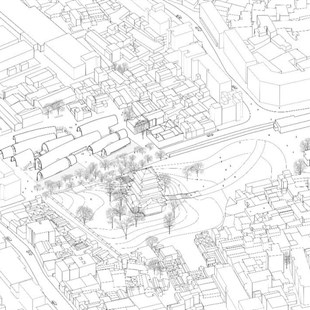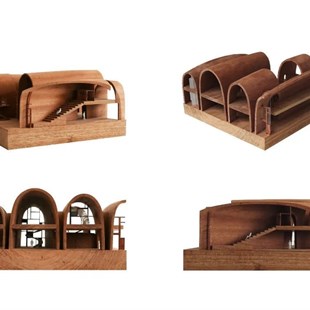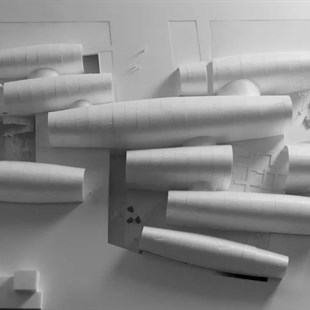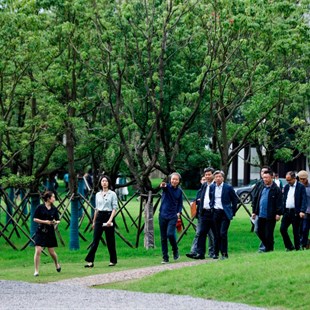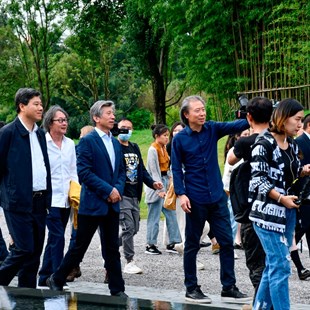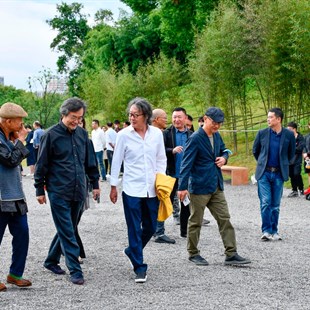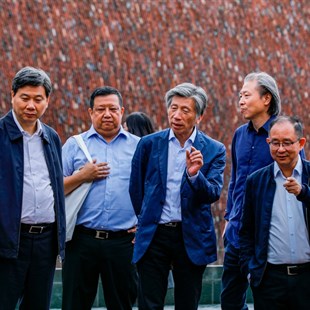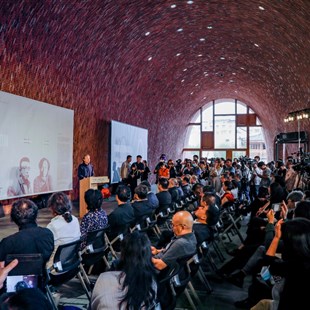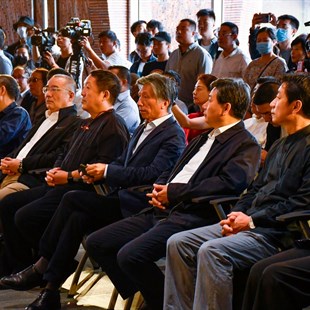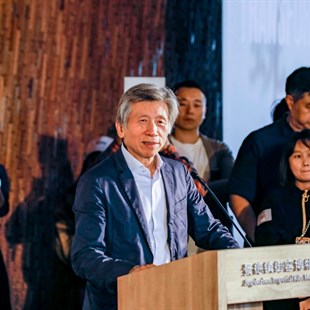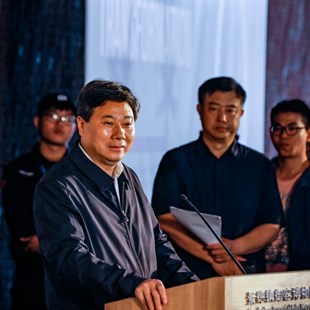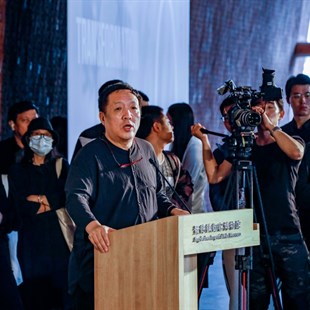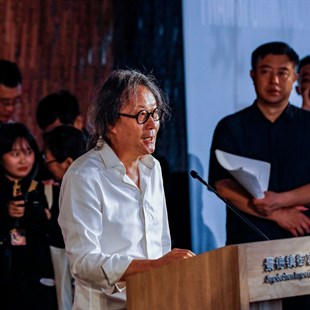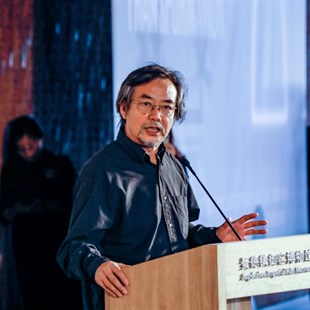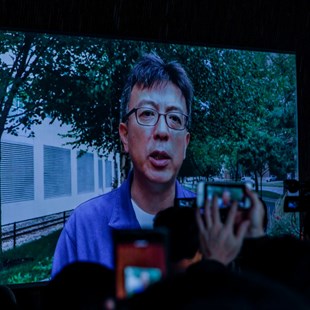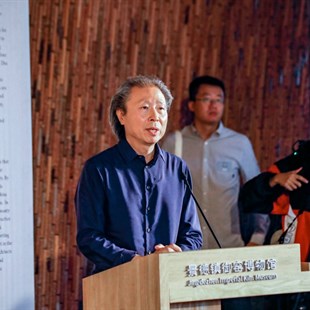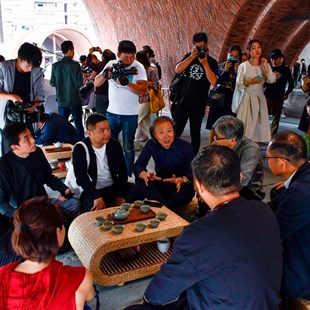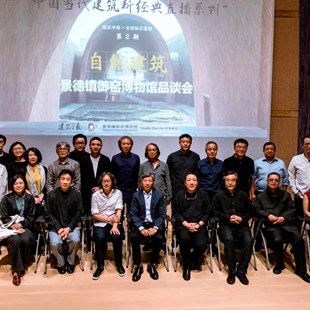
Located in the center of the historical area, the site of Jingdezhen Imperial Kiln Museum is adjacent to the Imperial Kiln ruins that are surrounded with many ancient kiln complexes. Jingdezhen is known as the “Porcelain Capital” in the world because it has been producing pottery for 1,700 years. “The porcelain kiln in Jingdezhen preserves the temperature of memories that is inseparable from the lives in this city.” Jingdezhen grew naturally fitting into the valleys surrounded with rivers, hills and mountains because of the porcelain industry. The early settlements of the city developed around kiln complexes which included kilns, workshops and housing. The street pattern was generated by nature and the porcelain industry. Most of the small alleys in between kiln complexes approached the Chang river in order to transport porcelain products to the river, the main streets have always been along the Chang river so as to bring all businesses and commerce together.
“With a thousand years of glorious history, renowned in the world as the City of Porcelain, Jingdezhen has an outstanding presence in the new era,” commented by Fan Dian, President of CAFA. The opening exhibition invites four great masters with international influence into the field of contemporary art and architecture, Xu Bing, Sui Jianguo, Liu Xiaodong and Zhu Pei, who represent the academic level of the Central Academy of Fine Arts (CAFA), so as to exhibit their magnum opus. The exhibition embodies the new changes and achievements on the ideology and methodology of Chinese contemporary art since the start of the new century. The exhibition is generally planned by Fan Di’an, Chairman of China Artists Association and President of the Central Academy of Fine Arts and curated by well-known architect and critic Zhou Rong. Wang Mingxian, a scholar of architecture and art history was invited as the academic chair.
Entitled “Transformation”, the opening exhibition pays homage to Jingdezhen, the Thousand-year-old City of Ceramics in China. Porcelain originates from nothing but simple clay within the ground and through firing it turns into a great art form. With effort throughout generations, Jingdezhen keeps evolving and developing in different eras. The Imperial Kiln Museum inherits the essence of traditional architecture in Jingdezhen and reflects the boldness and creativity of this era. The opening exhibition of Jingdezhen Imperial Kiln Museum, with its motif of “transformation”, comes straight to the point discussing the intersection of history and reality, nature and culture.

Front Hall and Preface Hall ©SCHRAN

Observing the Kiln Site of Ming Dynasty from Outdoor Theater ©SCHRAN
On-site Spirit and Context Renewal: Architectural Concept of The Imperial Kiln Museum
The Imperial Kiln Museum comprises more than half a dozen brick vaults based on the traditional form of the kiln, each of the vaults is of a different size, curvature, and length. They were naturally applied into the site, carefully integrated with many existing ruins including a few ruins that were found after the construction.
Ancient Kiln Sites around the Museum ©CAFA ART INFO
The unparalleled, liner and arched structures of the museum, like old kilns, reach below the level of the street to not only give the flexibility to adapt itself into the complicated site, but also achieve the intimate scale of interior space. This strategy—in part also is a response to the height of the surrounding historical buildings—leads to productive ambiguity in relation to the building’s horizontal datum. The “insertion” of the building into the ground of the site produces a series of public spaces at street level; also, more importantly, it allows for the design of a number of more intimate open vaults, and courtyards within the museum. Most of the public spaces are covered under shade, protected from the rain because it is hot and there is a lot of rain during the summer in Jingdezhen. One of the open spaces, two open vaults sited in both ends, will also reveal the traces of the historic fabric on the site.

Restoration Site of Xu Kiln ©Studio Zhu-Pei
When one walks on the bridge and enters the foyer, and then turns left, you will pass a series of arched exhibition spaces that are varied in size and with contradicting openness (enclosed or open to the sky) to encounter a gentle stair at the end flowing down to the underground level with five sunken courtyards. Meanwhile you can obtain a three-in-one (kilns-porcelains-people) museum experience when you see the porcelain, ruins and sunken courtyards which create manifold layers’ of experiences with ancient bricks on the façade. As you turn right at the foyer, you will pass the bookstore, cafe, tea room and finally reach a semi-outdoor area under the arch, witnessing a picturesque scene: during the daytime surfaces on these arches reflect the waves of water while low horizontal gaps tempt people to sit down on the floor to see the long horizon of the imperial kiln ruins, without expectation. Similar surprises would be created when you see the Longzhu Pavilion of the imperial kiln ruins through the vertical seams when you are on the way to the auditorium before accessing the foyer.
Arch Structure (Observing from the Inside and Outside ©SCHRAN
Five sunken courtyards varied in size have different themes: gold, wood, water, fire, soil. Those five themes not only reflect old Chinese thinking about earth, but are also associated with porcelain making techniques.
The overall experience of the museum tries to rediscover the roots of Jingdezhen, to recreate the past experience among the kilns, porcelain and people.

Recycled Kiln Bricks ©Studio Zhu-Pei
“I was fascinated by the local ancient kiln tectonic and material. Looking into the past, craftsmen built the brick kiln without scaffolding in a very special way. The thin and light brick kiln achieved a maximum interior space with minimum materials, the brick kilns appeared in organic forms reflecting heat flow from one end to another,” said Zhu Pei, the architect for this museum.

Light from the Gap Between the Stairs and the Arch ©CAFA ART INFO

Light from the Side Curved Seam and the Light from the Straight Seam on the Left Side in the Lecture Hall ©SCHRAN
The basic structure of the museum is an arch structure system, it is made up of concrete poured in between two layers of masonry brick walls. There is a small arch of the layout perpendicular to connecting the two arches.
Using recycled kiln bricks to build the house and all kind of buildings is a significant character in Jingdezhen because brick kilns have to be demolished every two or three years in order to keep a certain thermal performance of the kilns. The entire city was covered by recycled kiln bricks. Those bricks record a warmth, inseparable from the lifeblood of the city. In the past, the children would take a warm brick from the firing kilns to place in their schoolbags to keep them warm through the whole day in the freezing winter.


People resting in the tea room can be seen through the long cracks in the exterior of the Museum

The "landscape" of residential buildings behind the Museum adds to the breath of life.
The materials of the museum are dominated by bricks, recycled old kiln bricks are mixed with new bricks together to reflect the local culture of construction.
This interweaving of two different historical phases proposed by the combination of new and old bricks must arouse interest, curiosity, create new questions and give new answers by interacting with the minds of people who inevitably evoke memories and enjoy a unique experience. The past cannot be erased but rewriting or recounting with a new awareness and maturity, a sort of contemporary archeology.
The visitor can have a 360-degree sensory experience through the repeated contact between exterior and interior that stimulates touch, smell, hearing and sight and transports the visitor into a sort of trip between past, present and nature.
Collision of Art and Architecture: Works by the Four Masters in the Exhibition
The exhibition invites four participating artists, Xu Bing, Sui Jianguo, Liu Xiaodong and Zhu Pei. Born in the 1950s and 1960s, the four artists have seen the social development as well as the integration of eastern and western ideological resources since the reform and opening-up of China, and with many rounds of transformation, they are motivated to seek new identities in the contemporary world that is still rapidly changing. All these artists are from the Central Academy of Fine Arts (CAFA), so this exhibition also reflects the transformation of CAFA’s development philosophy, from “Fine Art” to “Extensive Art”, allowing artworks in different fields to form a dialogue and eventually to be integrated into an urban space. This is the mission of CAFA that focuses not only on artistic creation but also on social dissemination.

Cloud Garden-Planting Trace#2,Sensitive resin 3D printing and steel frame,2018
Photo by CAFA ART INFO
Sui Jianguo: Cloud Garden-Planting Trace
With a brief bonding with the clay—a series of actions, namely connection, release and then separation—Sui taps into preconscious states informed by his expert sculptural sense. The negative space around the clay bears the traces of the positive impression of his hands. With this, these works take a different turn from those of Rodin and de Kooning, as they retain a direct association with the body’s role in the process, as self-portraits in the negative. What is left in the wake of Sui’s action is an object that was made without willfulness to shape it in any particular way—to mold, to add, or to subtract—that is, operations associated with traditional handcrafted sculpture. While the negative was always there, here it is amplified, not only as a dialogue between one’s hands and a malleable material, but as a dynamic manifestation of the ontology (existence) of the space between itself. It is also from this moment, when he started with this new mode of working, that he began collaborating with computer programmers and fabricators to realize his work in a process parallel to that of the Modern masters.
Sui’s Garden in the Cloud series are about the indexicality of the body. It’s not really a copy, it’s an imprint. But then the blow-up version is a digitized imprint replica, not totally disengaged from a mold copy, yet with new capacities, set apart from it. The question is whether the replica is bringing the body to life or manifesting a fragment of the ontology of space into its own metaphoric orbit. Perhaps Sui’s works are totems, stand-ins for human beings as transitional entities in the symbolic realm that will be transformed and amplified in their final monumental scale.


Background Story:Endless Brooks and Mountains, Multi-media installation/ Various materials behind the frosted glass,180cm×1080cm,2014
Xu Bing: Background Story: Endless Brooks and Mountains
The resulting image of the Background Story which is not an effect of the three dimensional illusion created by pigments but a manipulation of light and shadow. To describe it in another way, a filter transforms the light that passes through it in two ways, blocking out some things while letting others pass through. The frosted glass acts as a filter in the air.
Light is more versatile and subtle than the direct presentation of any other material. This is the richest "painting" in the world (in terms of the shades of black and gray and the color variants). This is the value and reason for this kind of "light painting".

Square Word Calligraphy: "Preface to The Poems Composed at The Orchid Pavilion" by Wang Xizhi, Ink on paper, 99X188cm; 9 sheets in total, 2017
Xu Bing: Square Word Calligraphy: "Preface to The Poems Composed at The Orchid Pavilion" by Wang Xizhi
Square Word Calligraphy is a form of writing designed by artist Xu Bing that appears Chinese, but is actually English. When confronted with this "English language Chinese Calligraphy" the audience gains from an experience never previously felt. Transitioning between the familiar and the foreign, our cultural preconceptions are challenged and new areas of thought lay open to us as we rediscover the basis of our recognition. In 1999, Xu Bing received the MacArthur Fellowship. His work embodies the artist's perspective on the connections between art, society and cultures.

DIARY OF AN EMPTY CITY 2, 250×300cm, 2015, Oil on canvas ©Liu Xiaodong Studio


Exhibition View
Liu Xiaodong: Diary of an Empty City 2
Diary of an Empty City 2 shows a body of work painted live on location during the summer of 2015, Liu Xiaodong has long been fascinated by the Chinese phenomenon of the "ghost city," which has frequently been portrayed by the Western press and by the aficionados of urban planning. The artist chose a propitious location in Ordos in Inner Mongolia, to set his latest scene for a live painting and a reflection on the Chinese "dream life" and "dream city" environment.
Ordos is situated in the centre of a region, which has some of the largest deposits of coal in China, and which has been transformed in record time from one of the poorest areas in China to one of the wealthiest. Local farmers and miners have become the protagonists of rags-to-riches stories, as regional and city governments have built the "dream city". Ordos is a giant metropolis with amazing infrastructure, including condominium towers, shopping with a population of approximately 20.000 inhabitants. It's a city without residents, an unfinished plan, a paradoxical place. The realization of a modern dream society, in terms of urban infrastructure it simply lacks inhabitants to fulfill its dream life.
Liu Xiaodong investigates the ideal of the dream life in the light of the current Chinese lifestyle, discreetly asking: "What is our dream?" Could the Chinese common man's search for his dream existence in some ways be an unattainable mirage? Liu Xiaodong also reflects on the question: "A ghost city or a crowded City; which is better?”
This painting was the focus of Liu Xiaodong's time in Ordos. In this work, the conflict between the traditional nomadic lifestyle of the Mongolian steppe and the modernity as embodied by the “ghost city” of Ordos comes to life. The nomads are trying to reclaim the city that they have lost in the name of economic development. The process is by no means easy, but in the end they are seemingly victorious. This painting fuses together the forms of Xiaodong’s imagination with the present reality, creating tableaux in which the struggles of reconciling modernity with tradition take on new life.
Liu Xiaodong: DONG, HOMETOWN BOY, and UUMMANNAQ CHILDREN’S HOME
DONG
The film follows the artist Liu Xiaodong as he paints a group of laborers near the Three Gorges Dam on the banks of Fengjie, a city about to be swallowed up by the Yangtze River.
The area is in the process of being "de-constructed" by male workers who form the subject of Liu's paintings. Liu later travels to Bangkok, where he paints Thai sex workers languishing in brothels.
Dong was screened at the 2006 Venice International Film Festival as part of its "Horizons" Program.
HOMETOWN BOY
Hometown Boy follows Xiaodong as he travels back to his hometown to visit his friends and paint them once again, more than 30 years after setting off for the big city.
Far more than a standard documentary, the film is an exploration of friends and nostalgia for a man that veered off in a very different direction from those he grew up with.
We see as Xiaodong visits with his friends, hearing stories from days gone by. While each of his friends is poses for him to paint, Xiaodong explains their connection and why he is posing them in such a specific manner, communicating their spirit and their story on his canvas.
Hometown Boy, was granted the Best Documentary honour at the 2011 Golden Horse Awards (Taiwan’s Oscars)
UUMMANNAQ CHILDREN’S HOME
The movie follows Liu Xiaodong in his journey to the town of Uummannaq on Greenland’s western coast in 2017.
Having set out with a poetic notion in mind of what he would encounter in Uummannaq, Liu quickly discovered a way of life that was at once thoroughly modern and set in its age-old traditions. What prominently featured in the documentary is Liu’s interactions with the children he met at Uummannaq’s orphanage - the world’s northernmost point.


Exhibition View of Works by Zhu Pei including Models and Manuscripts

Zhu Pei, Manuscript of the Imperial Kiln Museum 2016 ©Zhu Pei

Zhu Pei, Ceramic Model of the Imperial Kiln Museum 2020© Studio Zhu-Pei
Zhu Pei: Artworks Related to the Imperial Kiln Museum
1 Inheritance of Tradition—Installation of Porcelain Pieces Unearthed from the Imperial Kiln
The installation of porcelain pieces, Inheritance of Tradition, is placed next to the kiln ruins from the Ming Dynasty inside the museum. The installation transforms the ancient broken porcelain pieces unearthed in the imperial kiln as the background, with the imperial jars of the dragon pattern and other porcelain models from the imperial kiln placed in it, which shapes the feelings of time and space in transition and implies the unchanging theme of history and reality, inheritance and transformation.
2 Transformation—Installation of Kiln Bricks
The ancient city of Jingdezhen was built on the basis of the old kiln bricks. These old kiln bricks are marked by the firing processes that preserve the warm memory that is inseparable from the life of the city. Once again, they have become the main materials for the construction of the Imperial Kiln Museum. The art installation, Transformation, reflects the ancient wisdom in the city construction and contemporary consciousness of ecological and environmental protection, and transforms them into a creative contemporary architectural masterpiece.
3 Sublimity—Manuscript of the Imperial Kiln Museum
The sketches and manuscripts by the architect of the Imperial Kiln Museum are enlarged and printed on the canvas, chronologically narrating the artist's imaginative creative ideas and contemporary architectural thinking with translucent scrolls that spread along the pathway of the museum.
4 Sightseeing—Models of the Creative Process of the Imperial Kiln Museum
The creative process of the Imperial Kiln Museum is represented by the display of models in the form of a floating island. The viewer wanders through multiple models of different sizes and heights, which recreates the scene of the architect’s studio. These conceptual models vividly record the unique creative trajectory of the architect. Some of the models have been collected by MoMA in New York and the Pompidou Center in France.
5 Creativity and Originality—Zhu Pei on the Design of the Imperial Kiln Museum
In the documentary, Creativity and Originality, Zhu Pei elaborates on how he combines the creation of a new experience with the search for local construction rules and regional culture. Starting from both creativity and originality, he forms his own cognition and thinking on architectural artistry and locality.
Continuous "Transformation": Continuity of Cultural Context and Renewal of the Ancient Town
CAFA has long-reaching ties to Jingdezhen, so the establishment of the Imperial Kiln Museum and the four artists’ works can bring new opportunities to this city. By introducing first class art exhibitions to the city, the museum will help develop the reputation of the city to make it well known among more people in China and all over the world.
Rather than an ordinary museum, the Imperial Kiln Museum can be taken as a cultural imprint and node, or an emotional container that condenses the wisdom of Chinese life, and even a monumental architecture and sculpture. When looking up into the sky, the dots of lights, elegantly curved eaves have also constructed a contemplative atmosphere with calm water. To a certain degree, it has also been endowed with the significance of church-like spiritual architecture, with human history, vivid stories, life styles, modern construction, and cultural awakening are all woven to lift up the shining waves of landmark cultural activities. It also deserves careful appreciation from audiences for it is calm, classic and elegant, like a quite deep lake.


Zhu Pei guided the tour of the architecture and exhibition
Text (CN) by Zhang Yizhi, edited (EN) by CAFA ART INFO
Courtesy of the artists and organizer










